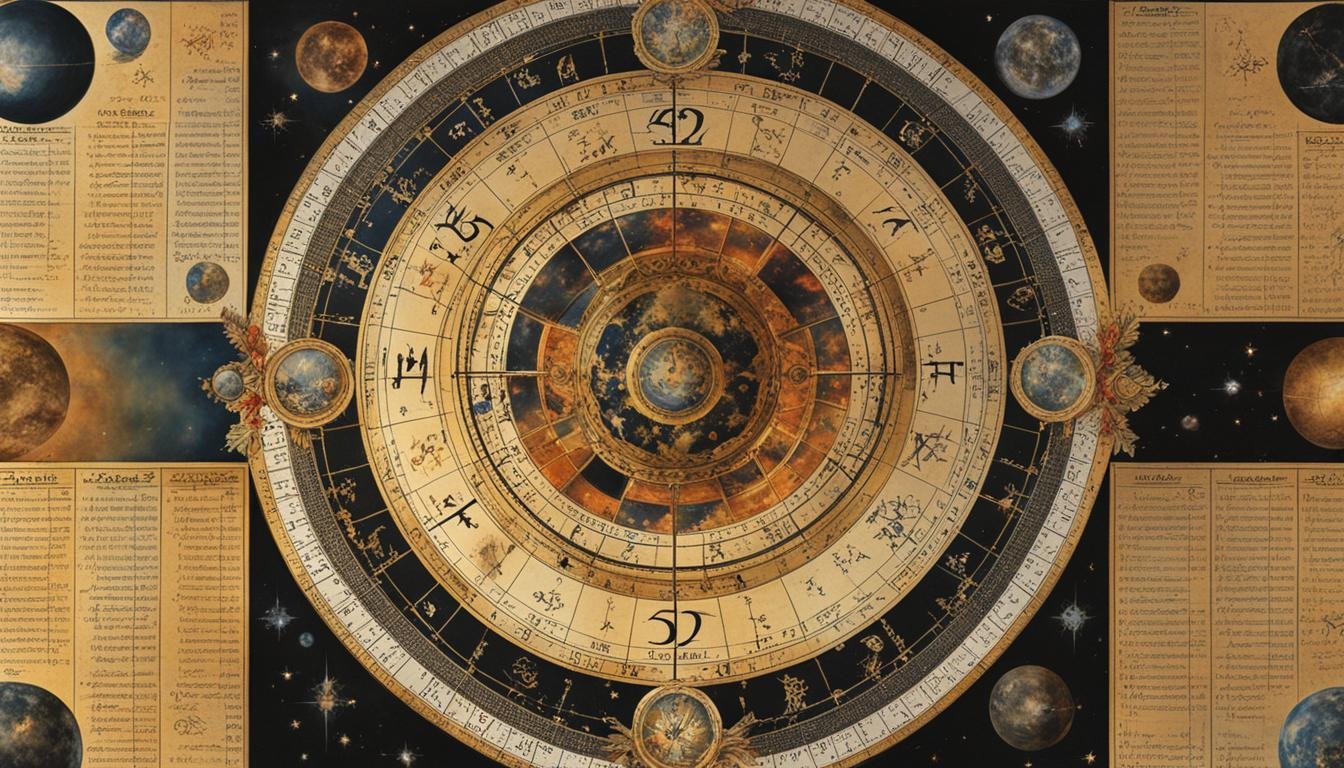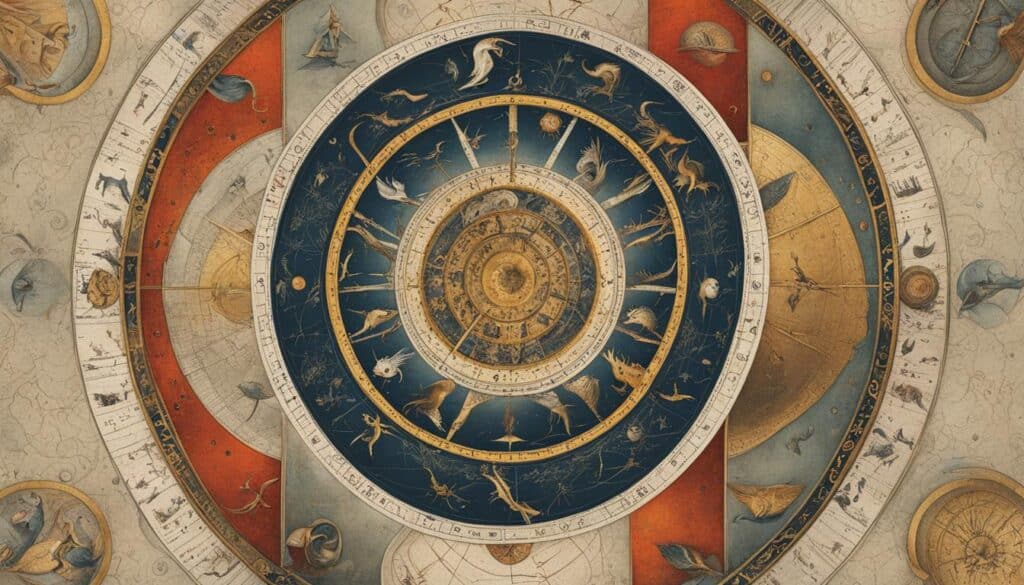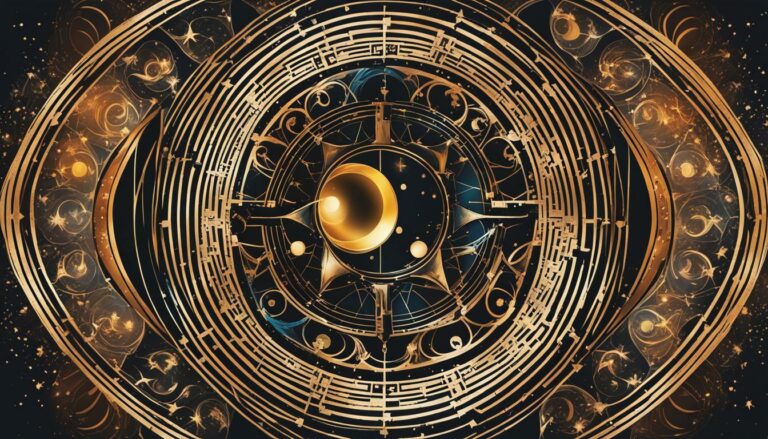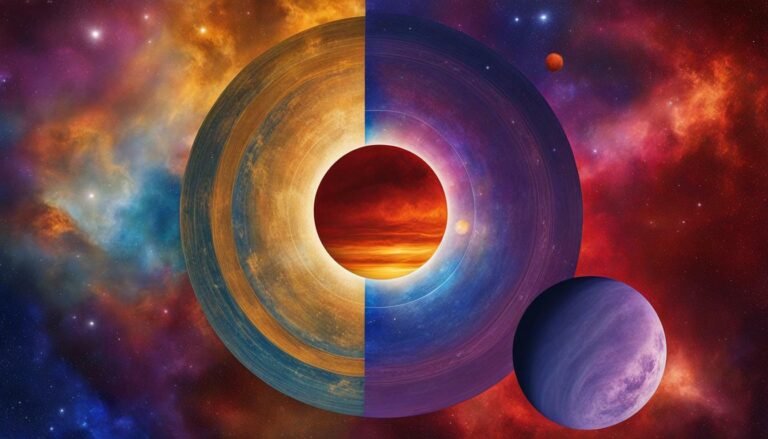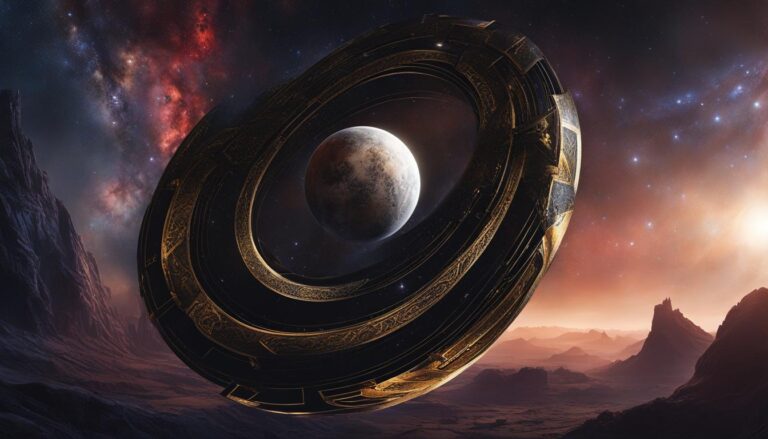How To Read Degrees In Astrology?
Have you ever wondered how to read degrees in astrology and what secrets they unlock within your astrology chart? As you dive into the intricate world of astrology, understanding degrees in astrology becomes paramount. Each degree is a fragment of the celestial story, pinpointing planets and their specific energies at your moment of birth. Interpreting astrology degrees can offer profound insights into your personality, path, and potential. Let’s embark on a journey to decode these cosmic coordinates and reveal the significant energies they hold for you.
Key Takeaways
- Recognize the vital role of degrees in your astrology chart for a detailed cosmic profile.
- Gain the skills to interpret the precise location of planets and signs linked to your birth time.
- Learn the relevance of degrees for unlocking deep insights into your astrological makeup.
- Embrace the impact of these degrees on your inherent strengths and life’s journey.
- Uncover the process for reading and interpreting astrology degrees for self-discovery.
Understanding the Astrological Chart Layout
If you’ve ever wondered how your personality and fate could be written in the stars, the first place to start is with your natal chart. This intricate map of the heavens at your moment of birth is the foundation for understanding astrology degrees interpretation and gleaning insights into astrological degree meanings. Let’s dive into the components that construct this celestial blueprint and uncover the significance it holds for you.
What is a Natal Chart?
Think of a natal chart as a snapshot of the sky taken from the very place and at the exact time you were born. This chart catalogs the positions of the sun, moon, planets, and astrological houses on the zodiac wheel, providing a personalized outline of your unique cosmic profile. With this detailed information, you can explore the various astrological degree meanings which can provide context to your life experiences, traits, and potential paths.
Importance of Your Exact Birth Information
Your birth information acts as the key to unlocking your natal chart’s secrets. It’s essential to know your date, time, and place of birth to ensure an accurate astrology degrees interpretation. Even a slight variance in the recorded time can shift the houses and change the degrees of the planets significantly, resulting in a different reading of your astral influences. This precision will guide you to a more authentic understanding of the zodiac’s impact on your personality and life journey.
Selecting the Appropriate House System
In astrology, the house system is a method used to divide the sky into twelve sectors that influence various aspects of your life. There are several house systems available, but for beginners, the Whole-Sign system might be the most straightforward because it aligns each house with a complete zodiac sign, simplifying the interpretation. Meanwhile, others like the Placidus system take into account the curvature of the earth and may result in houses spanning across more than one sign. Choosing the right system is crucial for correct astrological degree meanings and the context within your natal chart.
Identifying Zodiac Signs and Degree Markings
As you delve into the realm of astrology, grasping the concept of zodiac sign degrees is akin to learning the alphabet before forming sentences—it’s essential. The astrological chart is a 360-degree wheel, elegantly partitioned into twelve 30-degree segments for each zodiac sign. Understanding how to interpret these segments and their corresponding astrology degree symbols will grant you the knowledge to unveil the rich narratives hidden within your astrological birth chart.
Interpreting the Zodiac Sign Degrees
Each zodiac sign begins with a fresh dose of energy at 0 degrees, progressively building and evolving until it reaches the full maturation of its themes at 30 degrees. This journey through the degrees illuminates the subtle shifts in energy that are paramount in interpreting zodiac sign degrees. With the use of an astrology degree calculator, you can precisely pinpoint where each planet stands and uncover how its position affects your personality and fate.
Estimating Degrees if Not Clearly Marked
Sometimes, the cosmos doesn’t align things plainly for us, and certain degree markers might not be explicitly noted in your chart. Nevertheless, fear not—the knowledge that each zodiac sign is comprised of three 10-degree segments, known as decans, comes to your aid. By identifying which decan a planet falls into, you can estimate its degree. Whether a planet is nestled between two degrees, indicated as “minutes,” or stationed exactly, you gain insight by interpreting the significance of its position. Careful analysis of these degrees enriches your understanding, offering a more nuanced and personalized astrological interpretation.
Decoding Planetary Positions in the Zodiac
When you begin to untangle the complexities of your astrological chart, you’ll notice that the positions of planets play a critical role in shaping your life’s narrative. Charged with energy and profound meaning, these celestial bodies guide you towards understanding deeper aspects of yourself. By interpreting astrology degrees and recognizing the planetary glyphs, a new dimension of personal insight is unlocked. A planet’s degree within a zodiac sign not only reveals its strength but also provides a glimpse into the influence it casts on your disposition and life experiences.
Meaning of Planetary Glyphs
Each planet is represented by a unique symbol, or glyph, which encapsulates its energy in a single, enigmatic emblem. These glyphs are more than mere shorthand for your astrological components; they embody the essence of the planets they represent. For instance, the glyph for Mars reflects ambition and action, while Venus’s glyph embodies love and aesthetics. Recognizing these symbols is the first step in delving into the rich tapestry of your astrological story.
How Planetary Degrees Influence Personality
As you explore your chart, you’ll notice that every planet holds a position within a specific degree of a zodiac sign. This precise localization is where the nuances of astrology deepen. Planetary degrees personality influence is significant, as the position can amplify or diminish a planet’s impact. A planet positioned at the first or last degrees of a sign may express its qualities differently than one settled at its mid-point. Such subtleties offer you a more accurate and personalized astrological interpretation, helping you to not just understand your challenges and talents, but to embrace and cultivate them fully.
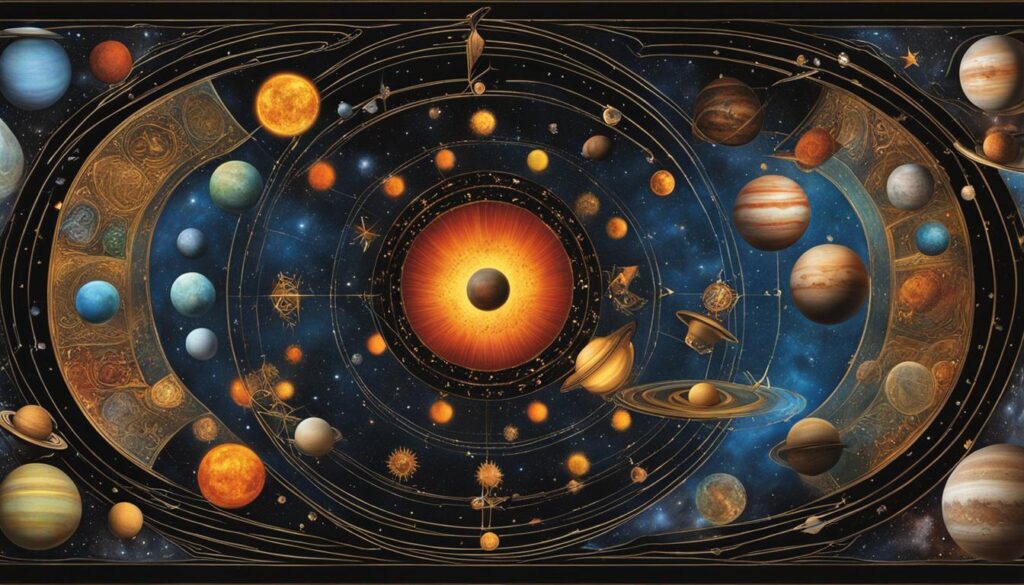
- A planet near the beginning of a sign introduces a theme of initiation and potential.
- Conversely, a planet at a sign’s end suggests the culmination of energies and experiences.
- Central degrees indicate a strong, consolidated presence of a planet’s attributes within a sign.
As you interpret the intricate language of the heavens, you become adept at reading the cosmic dance reflected in your own life. From the bold Sun defining your core identity, to the transformative whispers of Pluto, each degree tells a part of your story. Dare to decode the secrets of your planetary positions, and watch as the understanding of your unique astrological blueprint unfolds.
Crucial Aspects of Astrology Degree Symbols
When you dive into the world of astrology, interpreting astrology degrees becomes a fundamental part of understanding your chart. These degrees not only encode your personality traits but also map out the dynamic interplays between the cosmic bodies that govern your life. Specifically, the angles formed by planets to each other—known as aspects—are pivotal in translating celestial influence into everyday terms.
Major Planetary Aspects and Their Degrees
Major aspects are the superhighways of cosmic interaction, facilitating strong flows of energy between planets. They can bolster or challenge personal growth, depending on the planets involved and the aspect in question.
- Conjunction (0°): A fusion of planetary energies that can intensify a planet’s influence.
- Sextile (60°): An aspect that promotes harmony and creativity, offering opportunities for growth.
- Square (90°): Reflects tension and conflict, driving the need for action and resolution.
- Trine (120°): Indicates a flow of ease and talent, where things come together naturally.
- Opposition (180°): Represents polarities and potential for development through understanding opposite viewpoints.
Navigating Minor Aspects
While less emphasized than their major counterparts, minor aspects in astrology add a layer of depth and complexity to your chart.
- Quincunx (150°): Unveils karmic lessons and adjustments necessitated by shifting life phases.
- Quintile (72°): Encourages expression of unique talents and unusual creative abilities.
- Septile (51.428°): Enigmatic and often overlooked, this aspect whispers of fated events and spiritual insights.
By taking into account the interplay of both major and minor aspects, you can craft a more nuanced and comprehensive narrative of your astrological profile. Keep in mind, the degrees signify much more than just numerical values; they symbolize a constellation of potentialities that can guide you through life’s intricate dance.
Reading Critical Degrees and their Impact
As you journey through the complexities of your natal chart, understanding the critical degrees in astrology can unlock profound insights into your personal growth and challenges. These specific degrees within the zodiac signs carry an amplified significance, often heralding major turning points or revealing hidden strengths.
Cardinal signs — Aries, Cancer, Libra, and Capricorn — resonate with the energizing influence of 0, 13, and 26 degrees. A planet positioned at these degrees in a cardinal sign manifests heightened dynamism and initiatory power. In the realm of fixed signs — Taurus, Leo, Scorpio, and Aquarius — take note of the 8, 9, 21, and 22 degrees. These are points where persistence and resilience are tested and honed. For mutable signs such as Gemini, Virgo, Sagittarius, and Pisces, the degrees to watch are 4 and 17, which can indicate pivotal changes or adaptability challenges.
Delve into the astrology house degrees to discover how these critical points interact with different life areas. For example, if a critical degree falls within your fourth house, the realm of family and roots may play a pivotal role in your life’s narrative.
- 0 degrees – A new cycle, brimming with potential and raw energy
- 13 degrees – A test of resilience, compelling you to rise above hardships
- 26 degrees – A call for closure, ushering in completion and resolution
- 8 and 9 degrees – Invoking deeper introspection and core transformation
- 21 and 22 degrees – Pushing for mastery, perfecting your craft or purpose
- 4 and 17 degrees – Portals for flexibility, demanding adaptation and nuanced understanding
These critical junctures are not mere coincidences; they embody the impact of critical degrees. Planets stationed at these potent points are like cosmic megaphones, amplifying their messages through lessons, talents, and sometimes trials that are integral to your life narrative.
Embracing the full spectrum of what critical degrees offer can propel you into a deeper introspection of your astrological landscape, highlighting the areas where your greatest potential and most significant challenges lie. Remember to approach your chart with openness and curiosity to truly harness the transformative power of astrology’s critical degrees.
How to Correctly Use an Astrology Degree Calculator
Delving into degree interpretation in natal charts can unlock a new realm of astrological understanding. Whether you’re a seasoned astrologer or a curious newcomer, using an astrology degree calculator is a valuable step to obtaining personalized insights. Let’s explore the straightforward steps to calculate planetary degrees and how they can shed light on your astrological profile.
Steps to Calculate Planetary Degrees
To begin, you’ll need your natal chart on hand. Here’s how you can use astrology degree calculators effectively:
- Identify the planet you wish to calculate the degree for – such as the Sun, Moon, or Mars.
- Look for the degree symbol (º) next to the planet’s glyph in your chart. This will show the exact degree within its zodiac sign.
- If the degree isn’t marked, estimate its position by considering that each zodiac sign spans 30 degrees. Start counting from 0º at the beginning of the sign.
- For a precise calculation, use an online astrology degree calculator by inputting your date, time, and place of birth.
Remember to take note of whether the planet is in the early, middle, or late degrees of a sign as this can influence its impact.
Interpreting Calculated Degrees for Insight
Once you’ve calculated the degrees, the next step is interpretation:
- Analyze each planet’s degree to discover how it plays into your overall character and life path.
- Consider the nuances that degrees can reveal – from highlighting personal strengths to uncovering potential challenges.
- Look into any critical degrees or if a planet is close to changing signs, which can signify important life themes or transitions.
- Reflect on how these degrees interact with the rest of your chart, creating a complex tapestry of astrological influence unique to you.
By following these steps to calculate planetary degrees and interpreting them with care, you’ll unearth rich, personal insights that could guide you to self-fulfillment and understanding. Grab your astrology degree calculator, and you’re ready to begin this insightful journey.
Role of Decans in Astrology Degrees Interpretation
Grasping the understanding degrees in astrology is crucial, but diving deeper reveals the importance of decans. These decans in astrology degree interpretation play a vital role in fine-tuning the celestial influences on your natal chart. Imagine each zodiac sign as a stage in a theater production, split into three unique acts or ‘decans,’ each with its own scene and characters that influence the overall story of your astrological profile.
In essence, decans enhance the specific nature of your planetary placements, shaping their potency and how they manifest in your life. For instance, if your sun is in the first decan of Gemini, you’ll show classic traits of Gemini, but if it’s in the second or third, nuances are introduced, blending in the overtones of related zodiac signs.
- The first decan of any sign displays the purest expression of the sign’s energy.
- The second decan, influenced by the next sign in the same element, adds a layer of depth to the personality.
- The third decan introduces a complex, nuanced blend from the succeeding sign of the zodiac.
By understanding degrees in astrology, especially the nuanced subtleties that decans present, you can achieve a more intricate understanding of your astrological chart. Your journey through life’s celestial map is marked by these degrees, and each decan you traverse offers its own unique gifts and challenges.
Analyzing Degree Influences in Natal Chart Houses
Embarking on a deep dive into your natal chart, you’ll find that degrees play a pivotal role in shaping the narrative of your astrological framework. Understanding the significance of each degree within the houses of your natal chart is an integral element of degree theory astrology. As you analyze degree influences, remember that they are not merely numbers; they are symbols of your life’s potential and challenges.
The Significance of House Degrees
When considering the houses of your natal chart, each house correlates to different facets of life, from your identity and values to relationships and career. The degrees attributed to these houses can be thought of as the ‘subtitles’ of your life’s chapters. They carry with them the distinct flavor of experiences, marking the intensity and the particular lessons that are to unfold in various areas of your life.
How Degrees Affect Planetary Influences Within Houses
Planets docked at specific degrees within your natal chart houses are like actors taking their positions on the stage of your life. The manner in which a planet expresses itself is significantly influenced by its degree. Critical degrees, such as those at the cusps or midpoints of houses, amplify the impact of a planet, calling your attention to certain spheres of experiences that might require your focus, adaptation, or mastery.
- Planets positioned at early degrees (0-3 degrees) of a house suggest an initiatory phase, where new lessons and fresh starts emerge.
- Mid-degree positions (around 15 degrees) often point to a phase of development and the full expression of that house’s potential.
- Late degrees (27-29 degrees) indicate a period of culmination and transformation into the next phase of experience.
Additionally, the blend of a planet’s nature with the characteristics of a house’s degree can unveil a nuanced understanding of your inherent tendencies and personal development. It is in the alignment of natal chart houses degrees with the planets that reside within them that we truly begin to comprehend the intricate dance of celestial influences over our terrestrial lives.
Integrating Degree Theory with Traditional Astrology
Embarking on the journey of depth astrology, you may have encountered the traditional concepts that have shaped interpretations for millennia. But when you weave in the intricate threads of degree theory astrology, pioneered by the renowned astrologer Nikola Stojanovic, the tapestry of your astrological understanding transforms into a vivid, multi-dimensional panorama. Let’s explore how each degree tells a story, offering a treasure trove of insights when applying degree meanings to your personal chart.
Concept and Origin of Degree Theory Astrology
Degree theory astrology is an avant-garde approach that assigns specific narratives and characteristics to each of the 360 degrees of the zodiac. This theory lifts the veil to reveal an additional layer of symbolism that enriches the astrological reading process. The genesis of this theory is attributed to Nikola Stojanovic, who suggests that each degree embodies a distilled essence of the zodiac signs and their rulerships, beyond the familiar Sun sign astrology.
Applying Degree Meanings to Enhance Interpretations
The practical application of degree theory in astrology takes an already personalized natal chart to unprecedented degrees (pun intended) of specificity. By understanding and applying degree meanings, you’re empowered to decode messages and life themes woven into each zodiacal degree. This nuanced perspective can guide you through life’s intricate puzzles and challenges, offering a compass forged from celestial wisdom.
- Review your chart with a focus on exact degrees, paying attention to significant angles and aspects.
- Examine the ruler of each degree, contemplating how its narrative interacts with the planet positioned there.
- Consider the interplay between traditional interpretation and degree meanings, acknowledging their synergistic potential.
As you sync the conventional with the esoteric, your astrological insights may well unfold in dynamic and transformative ways. Embrace the harmony of old and new, and let the fresh current of degree theory astrology infuse vitality into every cosmic discovery you embark upon.
Conclusion
The intricate tapestry of astrology degrees interpretation plays a pivotal role in the realm of personal insight and self-discovery. As you’ve ventured through the celestial intricacies of your natal chart, it’s become evident that understanding degrees in astrology is more than a mere calculation; it’s a journey into the heart of your astrological DNA. Each degree’s unique vibration orchestrates a part of your cosmic symphony, with planets, signs, and houses composing the melodies of your existence.
Through chart analysis, we’ve unlocked doors to deeper self-awareness, uncovering the layered complexities of personal influence that the stars and planets bestow. By learning how to read degrees in astrology, you have expanded your astrological toolkit, equipping yourself with the knowledge to navigate life’s ebbs and flows with greater clarity. The nuanced insights gained are akin to acquiring a map of your soul’s journey, charting a course that is inherently yours.
As you continue to apply these celestial insights, remember that each step taken in the realm of the zodiac is a step towards understanding the profound interplay between the cosmos and your individual path. The principles of astrology are timeless, yet their application is as unique as you are. May your ongoing exploration of astrology degrees interpretation illuminate the shades of strength and potential that lie within your personal astroscape.
FAQ
How do you read degrees in astrology?
To read degrees in astrology, start by examining your natal chart to find where each planet is located within the zodiac signs. Look for the degree next to the planet’s symbol, which indicates its precise position. Degrees help understand the strength of each planet’s influence and its relationship with other planets, based on aspects.
What is a Natal Chart?
A Natal Chart, also known as a birth chart, is an astrological map that captures the positions of the planets, the Sun, and the Moon at your exact time of birth, offering insights into your personality, life path, and various life experiences.
Why is your exact birth information important?
Exact birth information including date, time, and place is crucial because it determines the precise positions of planets and astrological houses in your natal chart. Even a small error in this data can significantly alter the interpretation of your chart.
How do you select the appropriate house system?
The selection depends on personal preference and the astrological tradition you follow. Options include Whole-Sign houses, which are user-friendly, or systems like Placidus, which take into account the tilt of the Earth relative to the location of birth.
How do you interpret the zodiac sign degrees?
Zodiac sign degrees are interpreted by considering the energy and characteristics of the sign a planet falls in, as well as the specific degree. This might involve looking into decans or critical degrees for a more nuanced interpretation of how the planetary energies manifest.
What if the degrees are not clearly marked on the chart?
If degrees are not clearly marked, you can estimate a planet’s position by recognizing that each zodiac sign covers 30 degrees, so you can divide the sign into three 10-degree decans to narrow down the approximate placement.
What do planetary glyphs represent?
Planetary glyphs are symbols used to represent the Sun, Moon, and other planets in your natal chart. Each symbol holds specific astrological meanings and influences over various aspects of your life and personality.
How do planetary degrees influence personality?
Planets located at certain degrees within a zodiac sign can enhance or weaken its influence on your personality. Degrees can also show the stage of development of a planet’s energy, and how it might manifest in character traits and life events.
What are the major planetary aspects and how do their degrees matter?
Major planetary aspects, such as conjunctions, sextiles, squares, trines, and oppositions, define the angles planets make with each other in your natal chart. The degrees at which these aspects occur can greatly influence their impact on your life.
How do you navigate minor aspects in astrology?
Minor aspects, such as quincunxes, quintiles, and septiles, involve nuanced angles between planets. They require a closer look at the specific degree points to understand their subtler influences on your character and experiences.
What is the impact of critical degrees in astrology?
Critical degrees are specific degrees in each zodiac sign that carry heightened significance. Planets positioned at these degrees point to more intense life themes, challenges, or extraordinary strengths in certain areas of your life.
How do you calculate planetary degrees?
Calculate planetary degrees by identifying the exact placement of each planet within a zodiac sign in your natal chart. This is determined by the degree and minute symbol next to the planetary glyph, or estimated if not explicitly marked.
Why is interpreting calculated degrees for insight important?
Interpreting calculated degrees provides deeper self-awareness and understanding of the unique influences that the positions of the planets have in your life. This insight can help uncover personal tendencies, strengths, weaknesses, and guide potential growth areas.
What role do decans play in astrology degrees interpretation?
Decans further subdivide each zodiac sign into thirds, each encompassing 10 degrees. They add layers of complexity to interpretations, as each decan carries different traits that can modify and refine the expression of planetary energies in your chart.
What is the significance of house degrees?
House degrees can reveal the nuanced areas of your life most likely to be influenced by the planets that occupy them. Degrees close to the cusps of houses are particularly potent and can indicate significant life themes or events.
How do degrees affect planetary influences within houses?
Degrees highlight the exact point of influence within a house, detailing the specific life areas that a planet will activate. They can also influence how a planet’s energy is expressed, whether it’s through inner transformation, external action, or interaction with others.
What is degree theory in astrology and who initiated it?
Degree theory is a branch of astrology that assigns specific interpretations and stories to each of the 360 degrees in a chart. It was initiated by astrologer Nikola Stojanovic and offers a unique layer of meaning to traditional astrological readings.
How do you apply degree meanings to enhance interpretations?
Applying degree meanings involves examining the specific degree each planet occupies, taking into account theories like Nikola Stojanovic’s, and blending them with the traditional astrological symbolism to deepen your understanding of the chart.

